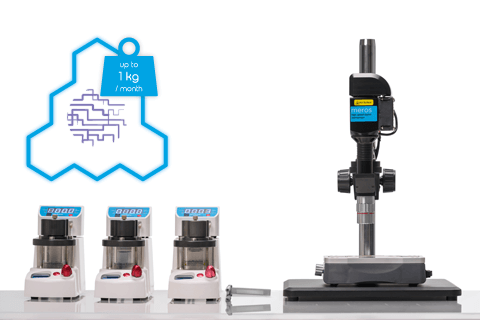The characterization of liquids flowing through rock is advantageous when trying to effectively extract crude oil deposits trapped in porous rock. Fluid flow through porous media is very complex and difficult to analyse optically. Crude oil movement in rocks is limited by parameters such as connectivity and tortuosity. Furthermore, the flow is influenced by complex interactions between the fluids themselves and the geometry and surface of the pore structure.
Microfluidic technologies are ideal for the development of new methods to extract crude oil that is trapped in porous rock, mixed with contaminants, or in a dynamic state where the extraction method may have to be altered quickly.
Microfluidic devices can simulate porous rock structure and enable easy monitoring and full visualisation of fluid flow through porous media. Operating over a wide temperature range of -15 ºC up to 150 ºC ( or up to 250 ºC with custom devices) and pressures ranging up to 30 bar (or 100 bar with custom devices), the glass devices offer outstanding chemical resistance allowing a broad range of solvents and chemicals to be used.
Dolomite offer a high quality microfluidic chips developed in collaboration with professor Marcio Carvalho from PUC-Rio, to allow easy pumping, mixing, optical analysis, as well as modelling of fluid flow in porous rock at given temperature and pressure.
Asphaltenes (n-heptane-insoluble and toluene-soluble components of carbonaceous material) constitute the largest aromatic fraction in petroleum. The level of Asphaltene differs between oil reservoirs and is regularly used as a quality marker for the oil well. Problems arise when the level of Asphaltene differs within the same well, as this means changing extraction method (hardware changeover) during extraction. Therefore, it is of high interest to determine the asphaltene content of crude oil ‘on-site’ in a quick reliable way.
Microfluidic devices allow asphaltene content measurements in less than 30 minutes. A concentration range of 0.1 to 15 % by weight can be measured, which is in line with the standard protocol IP143 and with high correlation to the ASTM D4124 and ASTM D974-97 methods.
Standardized optical measurements (e.g., ASTM D6560) are used. While this format is suited to miniaturization and point of need analysis, the main benefit of the H-cell method is the capacity to provide new analytical opportunities.
| Application | Test | Method | Key Process |
|---|---|---|---|
| Measurement of asphaltenes in crude-oil | Optical absorption technique | Asphaltenes are removed from the oil by the addition of n-alkane, leading to flocculation and subsequent filtration. The left over maltenes are then processed | Mixing, filtration and optical absorption, all done on a microfluidic chip |
| Enhanced oil recovery – microfluidics for rock characterization | Multiscale modelling for enhanced oil recovery | Pressure and temperature-based pumping/fluid replacement using porous media of various surface types | Emulsion transport/ replacement of oil with water at various temperatures and pressures |
| Characterising the asphaltene and Total Acid Number (TAN) carboxylic acid (naphthenic acid) content of crude oil | Diffusion-based separation that is only practical when a sample is manipulated at a microscale and thus is fundamentally different to previous methods for assaying these parameters that utilise solubility- or chromatography-based methods | Produce an asphaltene-free fraction, either hydrocarbon or methanol-soluble, that can be forwarded for further advanced analysis and used to determine asphaltene content and TAN value | Predictable micro-scale mixing of fluids |

Dolomite’s Porous Media System is the ideal solution for study and modulization of liquid flows in porous rocks, as it uses microfluidic methods to extract crude oil which can be trapped in porous rock, mixed with contaminants, or be in a dynamic state where the extraction method may have to be altered quickly.

Learn more about of the modelling of complex porous rock structures and how microfluidic chips enable applications in oil and gas extraction, environmental testing and groundwater analysis.

Read about how scientists explored the dispersion of data such as capillary desaturation curves and secondary waterflood recoveries using micromodels of different sizes and different pore patterns.

Read about findings which demonstrate that microfluidic experiments using translucent grains and fluids are a convenient tool for quantitative investigation of sub-resolution liquid/liquid displacement in porous media